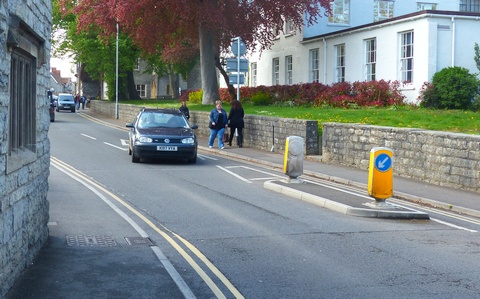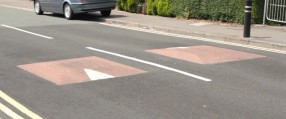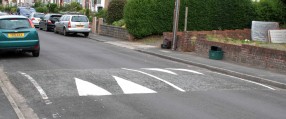Priority Chicanes

Priority Chicanes are also known as 'single lane working chicanes' or 'priority narrowing'
Single lane chicanes require one direction of traffic to give way to oncoming vehicles. The chicane normally consists of a raised kerb and bollard in one half of the road, with a sign to explain the vehicle traffic priority. For the lane without traffic priority, there are Give Way markings and hatching on approach to the chicane.
Groups of chicanes are normally placed with alternating priority down a road, so that each direction of vehicle traffic may have to stop and give priority in equal amounts.
Disadvantages
- Motor vehicles with priority are not required to reduce their speed
- Motor vehicles without priority are not required to reduce their speed if there is no oncoming vehicle approaching
- Motor vehicles without priority may race to the chicane before an oncoming vehicle approaches, or swerve dangerously around the chicane
- May cause long delays if there is increased vehicle traffic
- Some traffic is likely to transfer onto alternative routes, potentially causing a problem somewhere else

Considerations
- May cause traffic to divert to other routes
- Chicanes could create motor vehicle noise which is heard in residences nearby, as many vehicles will be stopping and starting. A greater distance between chicanes and residences will reduce this problem.
Use to discourage HGV movement
Chicanes can be used to discourage HGV movement. This is achieved by installing chicane priority in the opposite direction to the desired HGV rat-run route. This encourages HGV drivers to use alternative routes.
Restrictions
- Chicanes are normally used in residential areas
- Probably not appropriate for local distributor roads, where the chicanes may cause traffic queues
There's also some general restrictions to note for all schemes
Advantages
- Do not cause any vehicle passenger discomfort (in comparison to vertical treatments)
- Some chicane designs can allow cyclists to bypass them
- Emergency vehicles may be able to travel faster around a chicane compared to vertical treatments

Effectiveness
Chicanes are a horizontal treatment, which are generally expected to reduce accidents by around 29%.
Vehicles are likely to travel at around 21mph through a single lane chicane. Between chicanes, vehicles are likely to travel at 23mph.
Vertical treatments - such as speed cushions or speed tables - are more effective at reducing speeds.
Reducing vehicle speeds increases safety because:
- The vehicle has travelled less distance before the driver can react to a hazard
- Braking distance is reduced, so the vehicle can stop more quickly before a hazard
- A slower moving vehicle will exert less energy on occupants as the vehicle rapidly changes speed on impact (crashes)
- A slower moving vehicle will transfer less energy to a pedestrian in the event of a collision.

Advanced information
Motor vehicle speeds when travelling through a chicane are taken from TRL report 313 (Sayer et al.,1998). The report is based on data from 33 single lane working chicanes supplied by local authorities. All sites had a 30 mph speed limit except two, which had a 20 mph speed limit and a 60 mph speed limit. The 85th percentile speed between chicanes was 27mph, however there was no data available for average spacing between chicanes. Overall, the quality of this study is very poor - there is no methodological detail given, including any use of control sites, or before/after data collection periods. In the absence of other, specific analysis on chicane schemes, this paper is used as a guide for effects on speed.
29% reduction in accidents is taken from Mountain, Hirst and Maher (2005). The study calculated accident reductions from various different types of traffic calming measures. Local authority and police data were used throughout Great Britain from 150 speed management schemes on 20 mph roads. Analysis is particularly strong, with correction for change in flow, accident trend and regression to mean.
Factors associating reduced motor vehicle speed to road safety are based around Wilson et al (2010), who note the large body of research consistently linking casualty rate with speed (e.g. TRL 421).
References
Mountain, L., Hirst, W., Maher, M. (2005) Are speed enforcement cameras more effective than other speed management measures? The impact of speed management schemes on 30 mph roads. Accident analysis and prevention 37 pp. 742 - 754.
Sayer, I., Parry, D., Barker, J. (1998) Traffic calming - an assessment of selected on-road chicane schemes (TRL313). Transport Research Laboratory. Crowthorne, UK.
Taylor, M., Lyman, D., Baruya, A. (2000) The effects of drivers' speed on the frequency of road accidents (TRL421).Transport Research Laboratory. Crowthorne, UK.
Wilson, C., Willis, C., Hendrikz, JK., Le Brocque, R., Bellamy, N. (2010) Speed cameras for the prevention of road traffic injuries and deaths (Review). The Cochrane Collaboration. John Wiley & Sons.









